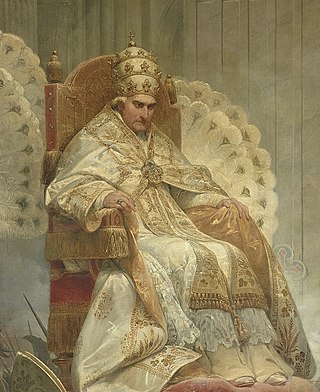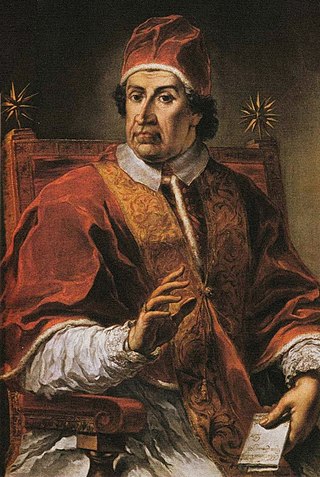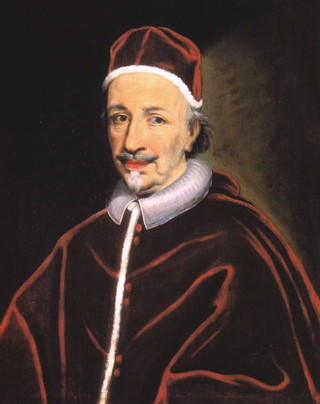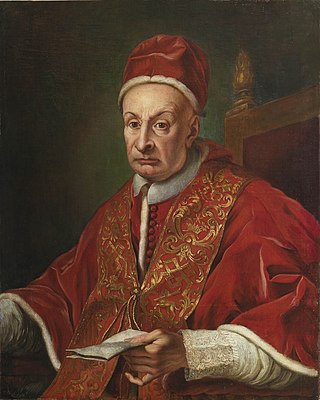
Pope Innocent XII, born Antonio Pignatelli, was head of the Catholic Church and ruler of the Papal States from 12 July 1691 to his death in September 1700.

Pope Innocent XIII, born as Michelangelo dei Conti, was head of the Catholic Church and ruler of the Papal States from 8 May 1721 to his death in March 1724. He is the most recent pope to date to take the pontifical name of "Innocent" upon his election.

The papal conclave held from 24 February to 31 March 1829 to elect a successor to the recently deceased Leo XII resulted in the accession of Cardinal Francesco Castiglioni, who took the name Pius VIII.

The papal conclave held from 2 to 28 September 1823 ended with the election of Annibale della Genga to succeed the death recently deceased Pius VII as pope. Della Genga took the name Leo XII.

Alessandro Albani was a Roman Catholic cardinal, but should be best remembered as a leading collector of antiquities, dealer and art patron in Rome. He supported the art historian, Johann Joachim Winckelmann and commissioned paintings from Anton Raphael Mengs. As a cardinal he furthered the interests of the governments of Austria, Savoy and Britain against those of France and Spain; he was a noted jurist and papal administrator in his earlier career. Upon his death he was the last cardinal created by Pope Innocent XIII.
Jus exclusivae was the right claimed by several Catholic monarchs of Europe to veto a candidate for the papacy. Although never formally recognized by the Catholic Church, the monarchs of France, Spain and Austria claimed this right at various times, making known to a papal conclave, through a crown-cardinal, that the monarch deemed a particular candidate for the papacy objectionable.

The 1492 papal conclave was convened after the death of Pope Innocent VIII. It was the first papal conclave to be held in the Sistine Chapel.

A crown-cardinal was a cardinal protector of a Roman Catholic nation, nominated or funded by a Catholic monarch to serve as their representative within the College of Cardinals and, on occasion, to exercise the right claimed by some monarchs to veto a candidate for election to the papacy. More generally, the term may refer to any cardinal significant as a secular statesman or elevated at the request of a monarch.

The 1758 papal conclave, convoked after the death of Pope Benedict XIV, elected Cardinal Carlo Rezzonico of Venice, who took the name Clement XIII.

Sebastiano Antonio Tanara was an Italian cardinal.

The 1774–75 papal conclave, was convoked after the death of Pope Clement XIV and ended with the election of Cardinal Giovanni Angelo Braschi, who took the name of Pius VI.

The 1769 papal conclave, was convoked after the death of Pope Clement XIII. It elected as his successor Cardinal Lorenzo Ganganelli, who took the name Clement XIV.

The 1585 papal conclave, convoked after the death of Pope Gregory XIII, elected Cardinal Felice Peretti Montalto (O.F.M.Conv), who took the name Sixtus V. Forty-two of the sixty cardinals participated in the conclave. The absence of thirty percent of the cardinalate makes this conclave one of the most sparsely attended in the history of the modern Roman Catholic Church. Fourteen of Gregory XIII's thirty cardinals failed to attend, a startlingly high number.

The 1655 papal conclave was convened following the death of Pope Innocent X and ended with the election of Cardinal Fabio Chigi as Alexander VII. The conclave quickly reached a deadlock, with Giulio Cesare Sacchetti receiving 33 votes throughout the conclave, but never securing enough for his own election. After several months of deliberation and negotiation, Chigi was elected Pope when Cardinal Mazarin, the leader of the French government, consented to Chigi's election at the request of Sacchetti.

The 1689 papal conclave was convened after the death of Pope Innocent XI. It led to the election of Cardinal Pietro Vito Ottoboni as Pope Alexander VIII. The conclave saw previous factions join together because they lacked numerical strength, and saw the rise of the zelanti as a political force in the election of the next pope. Ottoboni was eventually unanimously elected with the consent of the secular monarchs, becoming the first Venetian in over 200 years to be elected pope.

Fabrizio Paolucci was an Italian cardinal in the Roman Catholic Church, appointed by Pope Innocent XII.

The 1700 papal conclave was convened following the death of Pope Innocent XII. It ended in the election of Cardinal Giovanni Albani as Pope Clement XI. The conclave saw a rise in the dominance of the zelanti faction College of Cardinals. It remained deadlocked for a month until the death of the childless Charles II of Spain. The cardinal electors anticipated that his death without a clear heir would cause a political crisis, and moved to elect a pope that was seen as non-partisan.

The 1691 papal conclave was convened on the death of Pope Alexander VIII and ended with the election of Cardinal Antonio Pignatelli as Pope Innocent XII. It lasted for five months, from 12 February to 12 July 1691. The conclave became deadlocked after Catholic monarchs opposed the election of Gregorio Barbarigo, who some members of the College of Cardinals also viewed as too strict. The conclave only ended in the July when cardinals started to become ill from the heat, and after French cardinals agreed to vote for Pignatelli despite him coming from Spanish-controlled Naples.

The 1724 papal conclave was called upon the death of Pope Innocent XIII. It began on 20 March 1724 and ended on 28 May that year with the election of Cardinal Vincenzo Maria Orsini, a Dominican friar, as Pope Benedict XIII. The conclave was made of largely the same electors that had elected Innocent in 1721 and the same factions dominated it. Multiple attempts were made to elect candidates that would be acceptable to the various Catholic monarchies at the time, but none were successful until May. Benedict resisted his own election for two days before being convinced to accept it.

The 1730 papal conclave elected Pope Clement XII as the successor to Pope Benedict XIII.



















